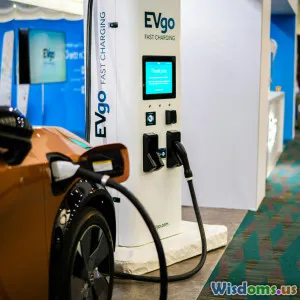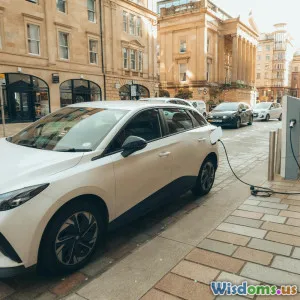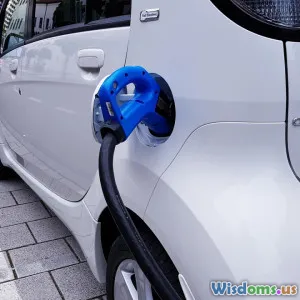
Why Secondhand Electric Cars Are Gaining Momentum in 2024
13 min read Explore why secondhand electric cars are surging in popularity in 2024, with analysis on market drivers, buyer benefits, economic factors, and real-world examples. (0 Reviews)
Introduction: The Quiet Revolution of Secondhand Electric Cars
Picture the city streets of 2024: the low hum of electric vehicles (EVs) is no longer rare—it's the new normal. But, look closer at dealership lots and online auto portals, and a clear trend emerges: secondhand electric cars are dominating searches and sales records like never before. What’s fueling this remarkable rise? Why are more drivers—young, old, urban, rural—choosing a previously owned EV over shiny gasoline alternatives or even brand-new electric models? The answer isn’t just about cost (though it plays a role). It’s a multifaceted narrative involving evolving market forces, environmental shifts, governmental incentives, and quietly maturing technology. Let’s dive deep into why 2024 is shaping up as the year when used electric cars go mainstream.
The Market Momentum: Numbers That Speak Volumes
Explosive Growth in the Used EV Market
The pre-owned electric car market has historically trailed conventional used cars, hampered by high prices, sparse inventories, and uncertainties surrounding battery lifespans. Fast-forward to 2024, and we’re witnessing a shift of tectonic proportions. Data from the International Energy Agency (IEA) reveal that the global secondhand EV market is projected to double its volume from just three years prior, with Europe and North America leading the surge. In the UK, for example, used EV sales doubled in Q1 2024 compared to the same period in 2022. Similarly, U.S. online car retailer Carvana reports that its pre-owned EV sales have tripled since the end of 2021, driven by increased inventory and shopper confidence.
Prices: The Great Equalizer
Arguably, the most important factor igniting this boom is falling prices. A 2023 study by Edmunds found that the average price of a three-year-old used EV dropped 17% year-over-year, making them affordable for a much broader swath of buyers. Models like the Nissan Leaf, Chevrolet Bolt, and previous-generation Tesla Model 3—once aspirational—are now within easy reach for middle-income families, students, and commuters.
Example: A 2020 Chevy Bolt, which launched at over $36,000, can now be found in the U.S. for less than $19,000—a stunning price reduction compared to older, used gasoline vehicles of comparable age.
Tech Advances Reduce Buyer Hesitancy
Battery Longevity: Perceptions Meet Reality
A decade ago, buying a secondhand electric vehicle was a gamble, largely due to perceived risks around expensive battery replacements. However, real-world data are reshaping these beliefs. According to a 2024 study by Recurrent, most modern EV batteries retain about 80% of their original capacity after 8–10 years—a figure far better than many buyers expected.
Quote: “The belief that EV batteries are obsolete after three years is simply unfounded,” says Liz Najman, head of market research at Recurrent. “We routinely see Teslas and Nissan Leafs over seven years old still delivering impressive range.”
Rapid Charging Infrastructure Growth
Another previous roadblock—the scattershot availability of charging stations—has also seen a remarkable turnaround. The Global EV Outlook 2024 cites a 42% increase in public charging points (fast and slow) worldwide, making longer journeys and routine charging far less problematic for secondhand EV owners. For instance, in the U.S., the number of fast-charging stations grew from 18,000 in early 2021 to more than 32,000 in 2024, according to the Department of Energy.
--
The Policy Push: Governmental Incentives Fuel the Trend
Federal and State Rebates in the Secondhand Market
Since 2023, many countries have widened their incentive net to capture not just buyers of brand-new EVs, but also those opting for certified pre-owned models. In the U.S., the Inflation Reduction Act enabled tax credits of up to $4,000 for qualifying used EV purchases (with certain income and vehicle price limits). European nations, such as France and Germany, have also ramped up rebates for pre-owned low-emission vehicles, narrowing the price gap further between combustion and electric options.
Example: As of 2024, Californian drivers may receive up to $5,000 in combined federal and state incentives toward a certified used EV—sometimes bringing the effective price below competing gasoline cars.
Regulatory Restrictions on Gasoline Vehicles
Adding urgency, several cities and nations are enacting stricter emission standards and low-emission zones (LEZs) that prohibit or penalize older, high-polluting vehicles, while often allowing electric cars (new or used) unfettered access. London’s Ultra Low Emission Zone, for instance, has prompted a brisk trade in used EVs among city commuters and gig workers needing daily access.
Value Beyond Price: Secondhand EVs in the Real World
Reliability and Lower Maintenance Costs
Contrary to conventional wisdom, used EVs are increasingly recognized for their reliability. With far fewer moving parts than internal combustion engine (ICE) vehicles—no alternators, exhaust systems, oil changes, or timing belts—maintenance expenditures are routinely 20–40% lower per year. Industry analyst John Voelcker notes, “Several high-mileage Teslas and Leafs on the road demonstrate that well-looked-after EVs regularly reach 150,000 or even 200,000 miles with only modest battery degradation.”
Lower Total Cost of Ownership (TCO)
Accounting for up-front cost, government incentives, lower maintenance, and reduced fueling expenses, total cost of ownership for many used electric cars now undercuts their gasoline equivalents after just 3–4 years of typical use. The American Council for an Energy-Efficient Economy (ACEEE) calculated in early 2024 that a three-year-old used Hyundai Kona Electric could save an average owner $4,500 over four years compared to a similar gasoline SUV.
Environmental Benefits
For climate-conscious consumers, driving a preloved EV delivers doubly impactful benefits: It saves a running vehicle from the landfill and reduces new car manufacturing emissions—a win-win as auto sector decarbonizes. Recent MIT research found the carbon footprint attributable to an EV falls dramatically when it is driven longer and resold at least once, especially if additional battery life is utilized by future drivers.
Changing Consumer Perceptions: The New Cool
Secondhand EVs Shed Their Stigma
There was a time when buying a used electric car was considered a penny-pincher’s compromise or a leap into the unknown. Today, with Tesla’s robust resale market, Nissan’s CPO (certified pre-owned) EV guarantees, and passionate YouTube reviewers demystifying battery health checks, shopper anxiety is fading. Social media abounds with stories of commuters purchasing used Chevy Bolts or Renault Zoes and racking up huge value per mile, often outfitting their old EVs with new infotainment upgrades or creature comforts.
Age of Transparently Sourced Vehicles
As with other maturing tech markets, consumers gain confidence from richer data and transparency. New startups like Recurrent (U.S.), Autotrader (UK), and ChargedUp (EU) now provide detailed battery health reports, service histories, and range assurances for used EVs, turning buyer guesswork into educated decision-making.
Quote: “Just like checking the mileage and service book for a used diesel car, I saw a certified battery report for my Nissan Leaf,” says Emma Thornton, 33, a London public-school teacher. “It gave me the confidence to buy nearly new, and it’s been brilliant.”
Frequently Asked Questions—and Misconceptions—About Used EVs
- Is battery replacement unavoidable for all older EVs? Not necessarily; with most modern batteries designed for a long service life, careful buyers can often avoid unexpected replacements.
- Are non-Tesla charging networks sufficient? While infrastructure is best for Tesla drivers, rapid expansion means most major cities and highways now serve all major makes.
- Do government incentives apply to all pre-owned EVs? Incentive eligibility can vary based on year, price, model, and buyer income—important to research local guidelines.
Case Study: The California Shift
California’s strict emissions targets have created the largest U.S. secondhand EV market. In 2024, over 1 in 8 used vehicles sold in Los Angeles County is electric or plug-in hybrid, up from less than 1 in 25 just three years prior. Drivers cite a mix of high gasoline costs, frequent incentives, and reliable dealer-backed warranties as key decision factors. Maria Kim, an Uber driver in San Jose, explains, "I never thought I’d drive an EV until I saw I could save thousands and still have enough range for 200-mile days. My 2019 Bolt is the best decision I've made."
Expert Outlook: What’s Next for Pre-Owned EVs?
Industry forecasters anticipate this momentum will continue. As more new EVs enter the market, especially from competitive brands like BYD, Hyundai, and Volkswagen, lease returns and trade-ins will continue to swell the used inventory. Used car retailers are responding with better buyer protections, extended battery coverage, and even subscription models that let potential owners "try before you buy."
A 2024 BloombergNEF outlook suggests that by 2026, used electric and plug-in cars could account for over 10% of all used vehicle sales in developed markets, bridging the gap to full-scale EV adoption.
Conclusion: A Tipping Point for Affordable, Clean Mobility
The rise of the secondhand electric car in 2024 is no passing fad—it’s an inflection point for the global auto industry and a democratizing force for clean transport. Lower purchase costs, expanded incentives, tech reliability, and shifting cultural attitudes all play their part. But above all, this boom is powered by growing confidence that electric vehicles, old or new, offer a practical, eco-friendly, and economically compelling alternative for millions more drivers.
For potential buyers, now may be the best moment to make the switch. With growing inventories, unprecedented transparency, and plug-in infrastructure expanding daily, the case for a secondhand EV has never looked stronger. The quiet revolution of used electric cars is here—will you join it?
Rate the Post
User Reviews
Popular Posts



















